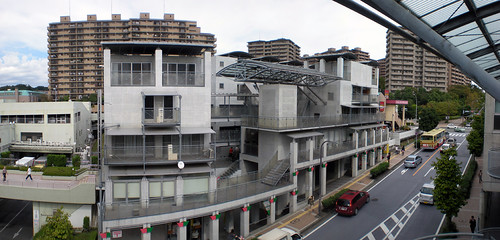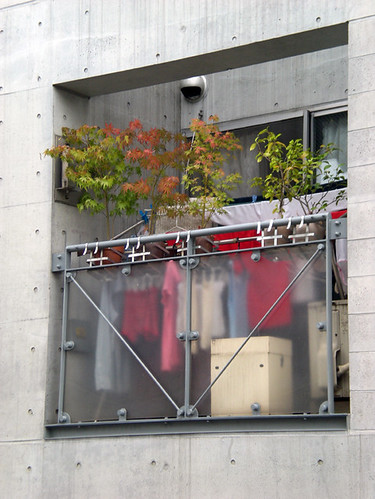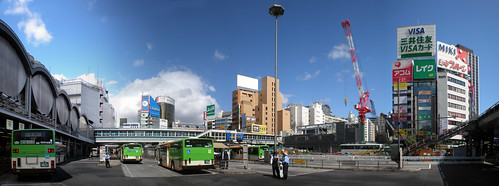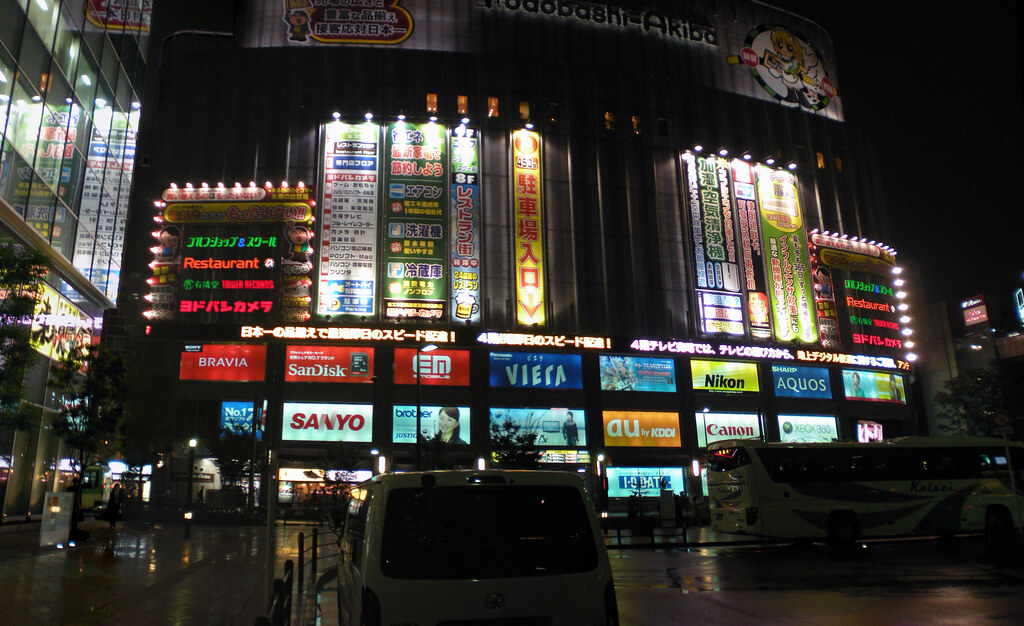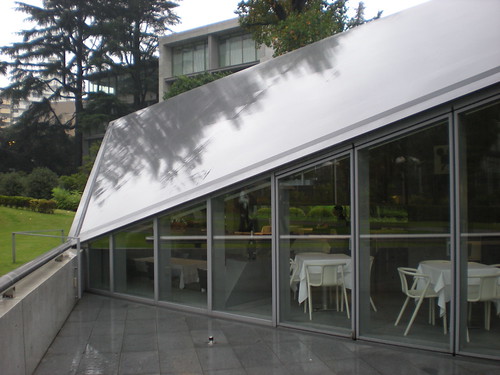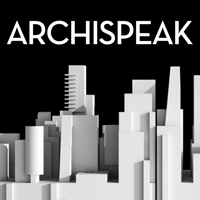I thought I’d take a moment away from all the architecture and rail stations to look at some of the food I ate in Japan. As you can probably tell, I ate my way through. Research purposes, of course.




Burger ‘n Fries: You have to understand, I’d been eating Japanese food for the better part of ten days, and while good, I was ready to eat something beyond familiar, hence, a burger and fries. I didn’t want to be the American at McDonalds (although Mickie D’s was packed) so I tried this Japanese favorite. Naturally, the meal included a fried chicken leg, a hamburger about the size of a single White Castle burger, a small fry and a small Coke. All for the budget price of about $11 American. The chicken leg was the best part. I’m not sure what the burger was seasoned with but it was distinctly Asian. I suppose they might say the say things about the hibachi steak house in my neighborhood.

 Chocolate Ice Cream Bar: Convenience stores, as in any major city, are very popular. 7 Eleven and Circle K were notable, along with several other Japanese varieties. I enjoyed checking them out for the bedazzling array of foods. This little guy was somethign between a dove bar and a chocolate bar. Very tasty.
Chocolate Ice Cream Bar: Convenience stores, as in any major city, are very popular. 7 Eleven and Circle K were notable, along with several other Japanese varieties. I enjoyed checking them out for the bedazzling array of foods. This little guy was somethign between a dove bar and a chocolate bar. Very tasty.

 Wafer Ice Cream Bar: This thing was pretty amazing. You know those little wafer crackers that come in either chocolate, strawberry or vanilla flavors? Imagine the vanilla version encasing ice cream. Yeah…exactly. Why we don’t have this, I’ve no idea. Sure, we have the ice cream cookie sandwich, but that’s nothing compared to this.
Wafer Ice Cream Bar: This thing was pretty amazing. You know those little wafer crackers that come in either chocolate, strawberry or vanilla flavors? Imagine the vanilla version encasing ice cream. Yeah…exactly. Why we don’t have this, I’ve no idea. Sure, we have the ice cream cookie sandwich, but that’s nothing compared to this.
 Train Station Sushi: In all the food Mr. Miyama took us to, we never hit a sushi place. I felt I would be remiss if I didn’t have sushi in Japan. I found this little place in the bowels of the Kyoto train station. It was actually really good…as if i’m an expert. I thought the rice was a little loose, but the fish was excellent.
Train Station Sushi: In all the food Mr. Miyama took us to, we never hit a sushi place. I felt I would be remiss if I didn’t have sushi in Japan. I found this little place in the bowels of the Kyoto train station. It was actually really good…as if i’m an expert. I thought the rice was a little loose, but the fish was excellent.

 Japanese Junk Food: The potato chips were really good. Sort of a Japanese red pepper flavored potato chip. Kinda hot, but really tasty. As for the bag with the smiley chick, instead of cheese flavoring, cross Cheetos with BBQ flavor and you’re there. I ate these while I watched Denver play the Patriots at 5:00am. Good football food, not so good for breakfast.
Japanese Junk Food: The potato chips were really good. Sort of a Japanese red pepper flavored potato chip. Kinda hot, but really tasty. As for the bag with the smiley chick, instead of cheese flavoring, cross Cheetos with BBQ flavor and you’re there. I ate these while I watched Denver play the Patriots at 5:00am. Good football food, not so good for breakfast.

 Japanese Vending Machine Fare: The Japanese are a vending machine culture. Every street corner, rail platform and back alley has a well lit vending machine happy and ready to dispense, sugar, carbonation and caffeine. With the cider, Imagine Woodchuck, but without the alcohol. Yeah, that’s what I thought, What’s the point? The CC Lemon – 70 Lemons worth of Vitamin C in every bottle. Who could refuse that? Carbonated lemonade. Nothing impressive. Move along.
Japanese Vending Machine Fare: The Japanese are a vending machine culture. Every street corner, rail platform and back alley has a well lit vending machine happy and ready to dispense, sugar, carbonation and caffeine. With the cider, Imagine Woodchuck, but without the alcohol. Yeah, that’s what I thought, What’s the point? The CC Lemon – 70 Lemons worth of Vitamin C in every bottle. Who could refuse that? Carbonated lemonade. Nothing impressive. Move along.
 Western Style Patries: The Japanese love quality. This was the most amazing doughnut I’ve ever had. Glazed with a hazelnut filling from Dean & Deluca in the Tokyo station. I was an hour early for my train, figured I’d splurge. I wasn’t disappointed.
Western Style Patries: The Japanese love quality. This was the most amazing doughnut I’ve ever had. Glazed with a hazelnut filling from Dean & Deluca in the Tokyo station. I was an hour early for my train, figured I’d splurge. I wasn’t disappointed.


 Kolaches, kolaches, kolaches: So the Japanese have totally embraced the sausage roll. These were in every patisserie and bakery at every rail station. They came in a host of different shapes, sizes, breads and all with a variety of ketchup, mustard and mayonnaise sauces. I felt it my obligation to try these everywhere I went.
Kolaches, kolaches, kolaches: So the Japanese have totally embraced the sausage roll. These were in every patisserie and bakery at every rail station. They came in a host of different shapes, sizes, breads and all with a variety of ketchup, mustard and mayonnaise sauces. I felt it my obligation to try these everywhere I went.

 Yakitori: How bad could pork, grilled and braised with a sweet sauce be? Um…not bad at all. Fraking incredible actually. They do know how to brew a good pilsner. I tried the dark beer, and the malt liquor…stick with the pilsner. I found these two in a park in Kyoto.
Yakitori: How bad could pork, grilled and braised with a sweet sauce be? Um…not bad at all. Fraking incredible actually. They do know how to brew a good pilsner. I tried the dark beer, and the malt liquor…stick with the pilsner. I found these two in a park in Kyoto.

 Mini Canned Coffee: So these little guys, akin to the Starbucks Doubleshot, are everywhere. Apparently BOSS is a huge brand in Japan. Tommy Lee Jones is plastered all over their current ad campaign. You can get them either cold or warm (they sit in heated racks at convenience stores or even hto out of vending machines). Either way they taste terrible. As for the “black” flavor, where the other tasted like bad day old coffee, this tasted like really dark bad day old coffee.
Mini Canned Coffee: So these little guys, akin to the Starbucks Doubleshot, are everywhere. Apparently BOSS is a huge brand in Japan. Tommy Lee Jones is plastered all over their current ad campaign. You can get them either cold or warm (they sit in heated racks at convenience stores or even hto out of vending machines). Either way they taste terrible. As for the “black” flavor, where the other tasted like bad day old coffee, this tasted like really dark bad day old coffee.
 Nagoya Station (名古屋駅, Nagoya-eki?) is a train station in Nakamura-ku, Nagoya, Aichi Prefecture, Japan. It is the world’s largest train station by floor area (446,000 m², 4,800,000 ft²)[1] and houses the headquarters of the Central Japan Railway Company (JR Central). Much of this space is located in the “JR Central Towers” atop the station, as well as in underground concourses. The current station complex was completed on December 20, 1999. An average of 1,140,000 people used it per day in 2005, making it the 6th busiest station in Japan.
Nagoya Station (名古屋駅, Nagoya-eki?) is a train station in Nakamura-ku, Nagoya, Aichi Prefecture, Japan. It is the world’s largest train station by floor area (446,000 m², 4,800,000 ft²)[1] and houses the headquarters of the Central Japan Railway Company (JR Central). Much of this space is located in the “JR Central Towers” atop the station, as well as in underground concourses. The current station complex was completed on December 20, 1999. An average of 1,140,000 people used it per day in 2005, making it the 6th busiest station in Japan.




